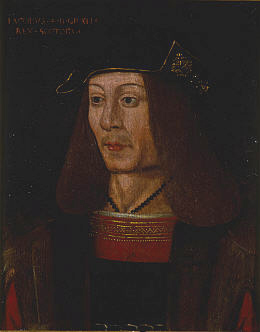<Back to Index>
- Engineer and Designer Gottlieb Daimler, 1834
- Painter Jean-Marc Nattier, 1685
- King of Scotland James IV, 1473

James IV (17 March 1473 – 9 September 1513) was King of Scots from 11 June 1488 to his death. He is generally regarded as the most successful of the Stewart monarchs of Scotland, but his reign ended with the disastrous defeat at the Battle of Flodden Field, where he became the last monarch from Great Britain to be killed in battle.
James IV was the son of James III and Margaret of Denmark, probably born in Stirling Castle. As heir apparent to the Scottish crown, he became Duke of Rothesay. His father was not a popular king and faced two major rebellions during his reign. During the second rebellion, the rebels set up the 15-year-old James as their nominal leader. His father was killed fighting the rebels at the Battle of Sauchieburn on 11 June 1488, and James took the throne and was crowned at Scone on 24 June. When he realised the indirect role which he had played in the death of his father, he decided to do penance for his sin. From that date on, he wore a heavy iron chain cilice around his waist, next to the skin, each Lent as penance.
James IV quickly proved to be an effective ruler. He defeated another rebellion in 1489, took a direct interest in the administration of justice and finally brought the Lord of the Isles under control in 1493. For a time, he supported Perkin Warbeck, the pretender to the English throne, and carried out a brief invasion of England on his behalf in 1496. However, he recognized that peace between Scotland and England was in the interest of both countries, and established good diplomatic relations with England, at that time emerging from a period of Civil War, and in 1502 signed the Treaty of Perpetual Peace with Henry VII. He also saw the importance in building a fleet that could provide Scotland with a strong maritime presence. James founded two new dockyards for the purpose and acquired a total of 38 ships for the Royal Scottish Navy, including the Margaret, and the carrack Michael or Great Michael. The latter, built at great expense at Newhaven and launched in 1511, was 240 feet (73 m) in length, weighed 1,000 tons and was, at that time, the largest ship in Europe.
James was a true Renaissance prince with an interest in practical and scientific matters. He granted the Edinburgh College of Surgeons a royal charter in 1506, turned Edinburgh Castle into one of Britain's foremost gun foundries, and welcomed the establishment of Scotland's first printing press in 1505. He was a patron of the arts, including many literary figures, most notably the Scots makars whose diverse and socially observant works convey a vibrant and memorable picture of cultural life and intellectual concerns in the period. Figures associated with his court include William Dunbar, Walter Kennedy and Gavin Douglas who made the first complete translation of Virgil's Aeneid in northern Europe. His reign also saw the passing of the makar Robert Henryson.
James was well educated and a fluent linguist. In 1499 the Spanish envoy Pedro de Ayala reported that he was able to "speak Latin, French, German, Flemish, Italian and the barbarian Gaelic, the native tongue of nearly all his subjects". He was the last King of Scots who is known to have spoken Scottish Gaelic. The king's interest extended beyond acquisition of languages; as part of a language deprivation experiment, James sent two children to be raised by a mute woman alone on an island, to determine if language was learned or innate. At Stirling Castle, James maintained an alchemical workshop with a furnace of the quintessence.
When war broke out between England and France as a result of the Italian Wars, James found himself in a difficult position as his obligations under the Auld Alliance with France conflicted with the treaty made with England in 1502. The new king of England,Henry VIII, attempted to invade France in 1513, and James reacted by declaring war on England. Hoping to take advantage of Henry's absence, he led an invading army southward, only to be killed, with many of his nobles and common soldiers, at the disastrous Battle of Flodden Field on 9 September, ending Scotland's involvement in the War of the League of Cambrai. A body, thought to be his, was recovered from the battlefield and taken to London for burial. Because he was excommunicated, the embalmed body lay unburied for many years in the monastery of Sheen in Surrey, and was lost after the Reformation. James's bloodstained coat was sent to Henry VIII (then on campaign in France) by his queen Catherine of Aragon. Rumours persisted that James had survived and had gone into exile, but there is no evidence to support them.